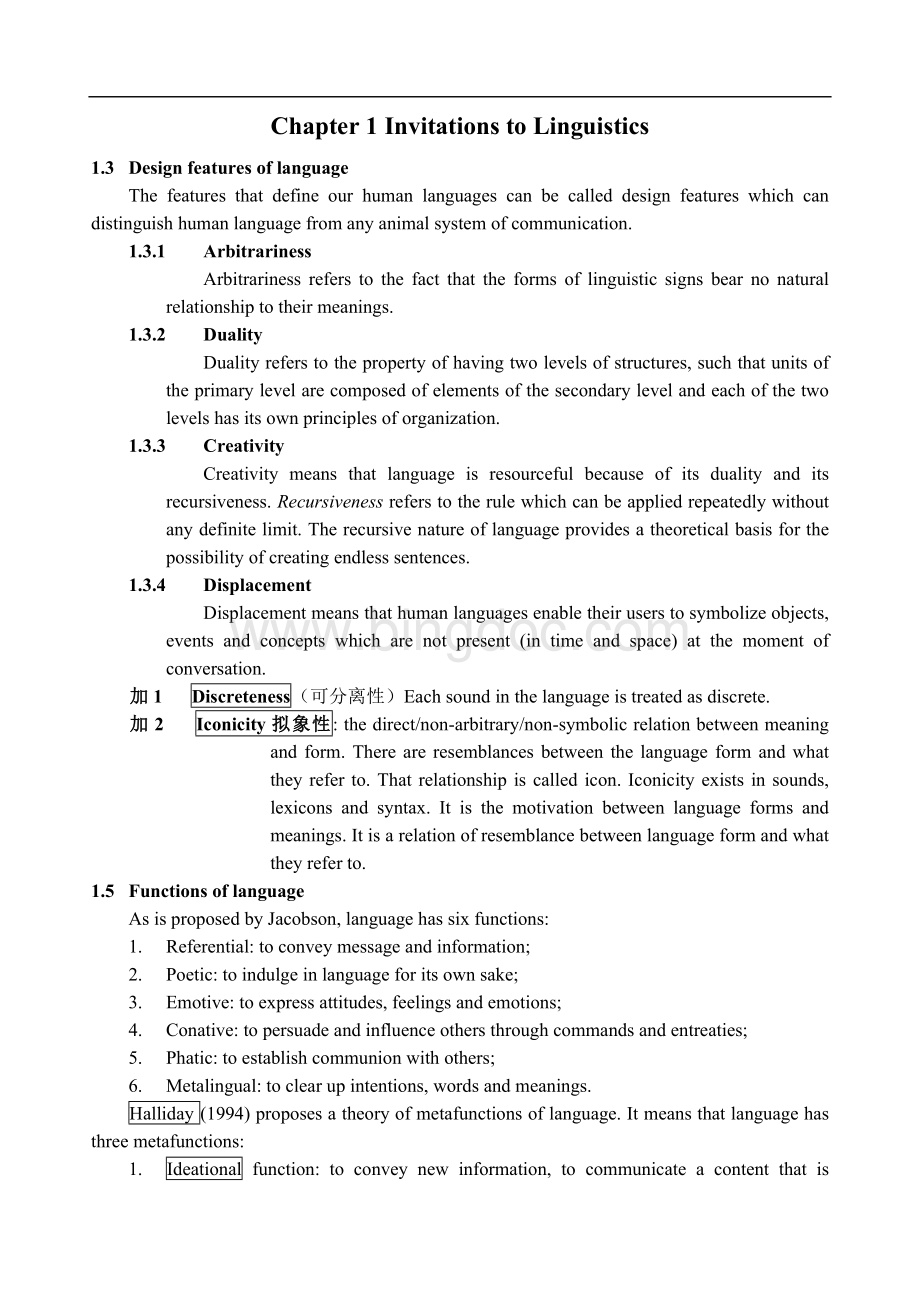胡壮麟《语言学教程》第四版笔记文档格式.doc
《胡壮麟《语言学教程》第四版笔记文档格式.doc》由会员分享,可在线阅读,更多相关《胡壮麟《语言学教程》第四版笔记文档格式.doc(70页珍藏版)》请在冰点文库上搜索。

加1Discreteness(可分离性)Eachsoundinthelanguageistreatedasdiscrete.
加2Iconicity拟象性:
thedirect/non-arbitrary/non-symbolicrelationbetweenmeaningandform.Thereareresemblancesbetweenthelanguageformandwhattheyreferto.Thatrelationshipiscalledicon.Iconicityexistsinsounds,lexiconsandsyntax.Itisthemotivationbetweenlanguageformsandmeanings.Itisarelationofresemblancebetweenlanguageformandwhattheyreferto.
1.5 Functionsoflanguage
AsisproposedbyJacobson,languagehassixfunctions:
1. Referential:
toconveymessageandinformation;
2. Poetic:
toindulgeinlanguageforitsownsake;
3. Emotive:
toexpressattitudes,feelingsandemotions;
4. Conative:
topersuadeandinfluenceothersthroughcommandsandentreaties;
5. Phatic:
toestablishcommunionwithothers;
6. Metalingual:
toclearupintentions,wordsandmeanings.
Halliday(1994)proposesatheoryofmetafunctionsoflanguage.Itmeansthatlanguagehasthreemetafunctions:
1. Ideationalfunction:
toconveynewinformation,tocommunicateacontentthatisunknowntothehearer;
2. Interpersonalfunction:
embodyingalluseoflanguagetoexpresssocialandpersonalrelationships;
3. Textualfunction:
referringtothefactthatlanguagehasmechanismstomakeanystretchofspokenandwrittendiscourseintoacoherentandunifiedtextandmakealivingpassagedifferentfromarandomlistofsentences.
AccordingtoHuZhuanglin,languagehasatleastsevenfunctions:
1.5.1 Informative
Theinformativefunctionmeanslanguageistheinstrumentofthoughtandpeopleoftenuseittocommunicatenewinformation.
1.5.2 Interpersonalfunction
Theinterpersonalfunctionmeanspeoplecanuselanguagetoestablishandmaintaintheirstatusinasociety.
1.5.3 Performative
Theperformativefunctionoflanguageisprimarilytochangethesocialstatusofpersons,asinmarriageceremonies,thesentencingofcriminals,theblessingofchildren,thenamingofashipatalaunchingceremony,andthecursingofenemies.
1.5.4 Emotivefunction
Theemotivefunctionisoneofthemostpowerfulusesoflanguagebecauseitissocrucialinchangingtheemotionalstatusofanaudiencefororagainstsomeoneorsomething.
1.5.5 Phaticcommunion
Thephaticcommunionmeanspeoplealwaysusesomesmall,seeminglymeaninglessexpressionssuchasGoodmorning,Godblessyou,Niceday,etc.,tomaintainacomfortablerelationshipbetweenpeoplewithoutanyfactualcontent.
1.5.6 Recreationalfunction
Therecreationalfunctionmeanspeopleuselanguageforthesheerjoyofusingit,suchasababy’sbabblingorachanter’schanting.
1.5.7 Metalingualfunction
Themetalingualfunctionmeanspeoplecanuselanguagetotalkaboutitself.E.g.Icanusetheword“book”totalkaboutabook,andIcanalsousetheexpression“thewordbook”totalkaboutthesign“b-o-o-k”itself.
1.6 Whatislinguistics?
Linguisticsisthescientificstudyoflanguage.Itstudiesnotjustonelanguageofanyonecommunity,butthelanguageofallhumanbeings.
1.7 Mainbranchesoflinguistics
1.7.1 Phonetics
Phoneticsisthestudyofspeechsounds,itincludesthreemainareas:
articulatoryphonetics,acousticphonetics,andauditoryphonetics.
1.7.2 Phonology
Phonologystudiestherulesgoverningthestructure,distribution,andsequencingofspeechsoundsandtheshapeofsyllables.
1.7.3 Morphology
Morphologystudiestheminimalunitsofmeaning–morphemesandword-formationprocesses.
1.7.4 Syntax
Syntaxreferstotherulesgoverningthewaywordsarecombinedtoformsentencesinalanguage,orsimply,thestudyoftheformationofsentences.
1.7.5 Semantics
Semanticsexamineshowmeaningisencodedinalanguage.
1.7.6 Pragmatics
Pragmaticsisthestudyofmeaningincontext.
1.8 Macrolinguistics
1.8.1 Psycholinguistics
1.8.2 Sociolinguistics
1.8.3 Anthropologicallinguistics
1.8.4 Computationallinguistics
1.9 Importantdistinctionsinlinguistics
1.9.1 Descriptivevs.prescriptive
Tosaythatlinguisticsisadescriptivescienceistosaythatthelinguisttriestodiscoverandrecordtherulestowhichthemembersofalanguage-communityactuallyconformanddoesnotseektoimposeuponthemotherrules,ornorms,ofcorrectness.
Prescriptivelinguisticsaimstolaydownrulesforthecorrectuseoflanguageandsettlethedisputesoverusageonceandforall.
Forexample,“Don’tsayX.”isaprescriptivecommand;
“Peopledon’tsayX.”isadescriptivestatement.Thedistinctionliesinprescribinghowthingsoughttobeanddescribinghowthingsare.Inthe18thcentury,allthemainEuropeanlanguageswerestudiedprescriptively.However,modernlinguisticsismostlydescriptivebecausethenatureoflinguisticsasasciencedeterminesitspreoccupationwithdescriptioninsteadofprescription.
1.9.2 Synchronicvs.diachronic
Asynchronicstudytakesafixedinstant(usuallyatpresent)asitspointofobservation.Saussure’sdiachronicdescriptionisthestudyofalanguagethroughthecourseofitshistory.E.g.astudyofthefeaturesoftheEnglishusedinShakespeare’stimewouldbesynchronic,andastudyofthechangesEnglishhasundergonesincethenwouldbeadiachronicstudy.Inmodernlinguistics,synchronicstudyseemstoenjoypriorityoverdiachronicstudy.Thereasonisthatunlessthevariousstateofalanguagearesuccessfullystudieditwouldbedifficulttodescribethechangesthathavetakenplaceinitshistoricaldevelopment.
1.9.3 Langue&
parole
Saussuredistinguishedthelinguisticcompetenceofthespeakerandtheactualphenomenaordataoflinguisticsaslangueandparole.Langueisrelativestableandsystematic,paroleissubjecttopersonalandsituationalconstraints;
langueisnotspokenbyanindividual,paroleisalwaysanaturallyoccurringevent.Whatalinguistshoulddo,accordingtoSaussure,istodrawrulesfromamassofconfusedfacts,i.e.todiscovertheregularitiesgoverningallinstancesofparoleandmakethemthesubjectoflinguistics.
1.9.4 Competenceandperformance
AccordingtoChomsky,alanguageuser’sunderlyingknowledgeaboutthesystemofrulesiscalledthelinguisticcompetence,andtheactualuseoflanguageinconcretesituationsiscalledperformance.Competenceenablesaspeakertoproduceandunderstandandindefinitenumberofsentencesandtorecognizegrammaticalmistakesandambiguities.Aspeaker’scompetenceisstablewhilehisperformanceisofteninfluencedbypsychologicalandsocialfactors.Soaspeaker’sperformancedoesnotalwaysmatchhissupposedcompetence.Chomskybelievesthatlinguistsoughttostudycompetence,ratherthanperformance.Chomsky’scompetence-performancedistinctionisnotexactlythesameas,thoughsimilarto,Saussure’slangue-paroledistinction.Langueisasocialproductandasetofconventionsofacommunity,whilecompetenceisdeemedasapropertyofmindofeachindividual.SaussurelooksatlanguagemorefromasociologicalorsociolinguisticpointofviewthanChomskysincethelatterdealswithhisissuespsychologicallyorpsycholinguistically.
1.9.5 Eticvs.emic
Beingeticmeansresearchers’makingfartoomany,aswellasbehaviorallyandinconsequential,differentiations,justasoftenthecasewithphoneticsvs.phonemicsanalysisinlinguisticsproper.
Anemicsetofspeechactsandeventsmustbeonethatisvalidatedasmeaningfulviafinalresourcetothenativemembersofaspeechcommunityratherthanviaappealtotheinvestigator’singenuityorintuitionalone.
Chapter2SpeechSounds
2.1 Speechproductionandperception
Phoneticsisthestudyofspeechsounds.Itincludesthreemainareas:
1. Articulatoryphonetics–thestudyoftheproductionofspeechsounds
2. Acousticphonetics–thestudyofthephysicalpropertiesofthesoundsproducedinspeech
3. Auditoryphonetics–thestudyofperceptionofspeechsounds
Mostphoneticiansareinterestedinarticulatoryphonetics.
2.3 Segments,divergences,andphonetictranscription
2.3.2 Phonetictranscription
InternationalPhoneticAlphabet(IPA):
thesystemofsymbolsforrepresentingthepronunciationofwordsinanylanguageaccordingtotheprinciplesoftheInternationalPhoneticAssociation.Thesymbolsconsistoflettersanddiacritics.SomelettersaretakenfromtheRomanalphabet,somearespecialsymbols.
2.4 Consonants
2.4.3 Mannersofarticulation
1. Stop/plosive:
2. Fricative:
3. (Median)approximant:
4. Lateral(approximant):
2.4.4 Placesofarticulation
1. Bilabial:
Aspeechsoundwhichismadewiththetwolips.
2. Labiodental:
Aspeechsoundwhichismadewiththelowerlipandtheupperfrontteeth.